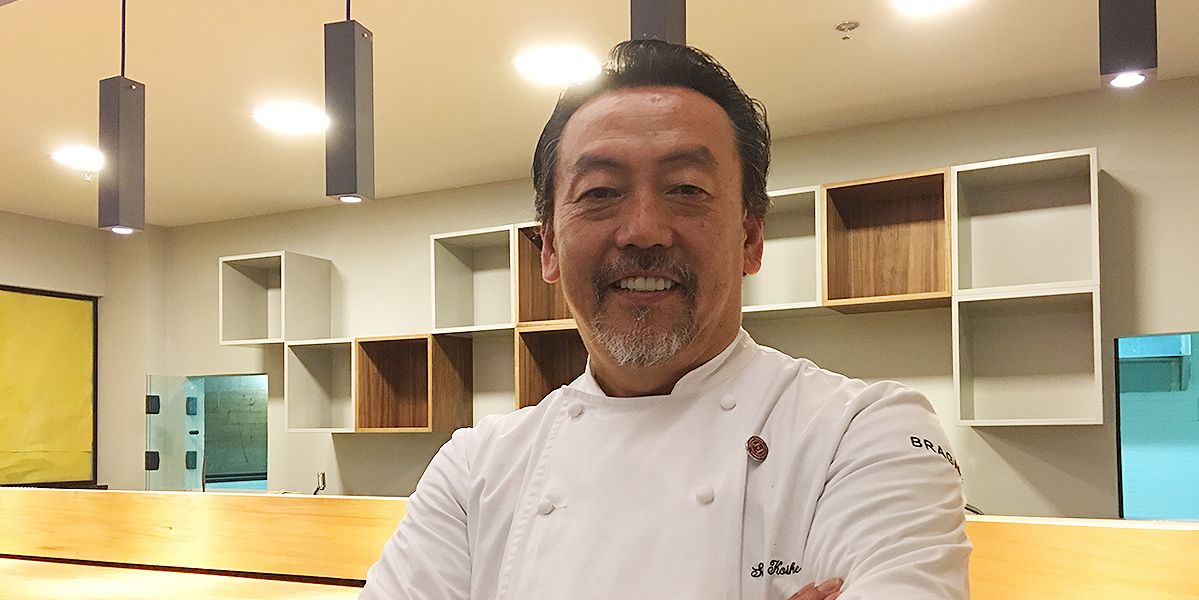
“Respect the Old. Welcome the New”: An Interview with Head Chef Sho Naganuma of Torasho Ramen & Charcoal Bar
My first impression of Head Chef Sho Naganuma, or Chef Sho for short, when I met him for the first time was that he had very bright blond hair.
My next impression of Chef Sho was his effervescent and approachable personality that belied his numerous years of experience concocting Japanese and French culinary treats in renowned Michelin-star restaurants around the world.
“Ohayo,” he said with a cheerful demeanor, referring to the Japanese greeting for “good morning”, despite not having much sleep after work the night before.
I returned his greeting, while still attempting to suss him out.
A bit of small talk then followed between both of us, as we exchanged views about our favorite Japanese films.
As much as I enjoyed the casual banter, I tried to get down to business soon after, considering his busy schedule as a head chef at Torasho Ramen & Charcoal Bar in the Tanjong Pagar district of Singapore.
It had been a long time since I last interviewed a chef, let alone a chef with a dazzling repertoire of Japanese and French cuisine up his sleeve.
After all, wasn’t Chef Sho previously the Executive Chef at the prestigious and multi-concept Hide Yamamoto at Marina Bay Sands? Didn’t he star in various television programs, including the luxury travelog “Great Dinners of the World” produced by the Asian Food Channel (AFC)? Hasn’t he rubbed shoulders with other internationally prominent chefs, including the likes of Nobuyuki Matsuhisa, whose eponymous “Nobu” restaurant empire stretches across five continents?
Well, notwithstanding his achievements, Chef Sho’s gregarious nature enabled me to effortlessly delve more into his background, as well as what led him to eventually set up and run Torasho Ramen & Charcoal Bar.
Born in Nagoya, Japan, Chef Sho made his first forays into cooking with his father who taught him how to prepare traditional Japanese dishes from the tender age of six. These experiences gleaned in early childhood ignited an interest in cooking in young Sho, one that became a life-long passion.
After years of accumulating experience in eminent and highly competitive kitchens, Chef Sho eventually crossed paths with the illustrious chef, Hide Yamamoto, in Los Angeles in 2002.
Both chefs, talented as they were, hit it off and subsequently worked together at the Mandarin Hotel in Washington D.C., and also cooperated for a high-profile opening event for the Mandarin Oriental in Tokyo. Their camaraderie and Chef Sho's devotion to his craft saw him helming Hide Yamamoto in Singapore, Chef Hide Yamamoto's maiden overseas venture beyond Japan.
Throughout his sharing, Chef Sho’s admiration for his friend Chef Hide Yamamoto’s Italian and French cuisine expertise was palpable.
No less tangible was Chef Sho’s esteem for Chef Nobuyuki (“Nobu”) Matsuhisa’s knack for blending traditional Japanese dishes with foreign ingredients to create delectable fusion delights.
It was Chef Nobu’s adventurous approach of combining Japanese and local ingredients from other parts of the world that enabled him to seamlessly introduce exquisite Japanese cuisine to foreign palates, Chef Sho asserted.

Take the ankimo, or monkfish liver, for example. While many an uninitiated customer previously had hesitated to take a bite of this Japanese delicacy, Chef Nobu’s culinary skills and ability to cater to local tastes eventually won them over.
In fact, one of Chef Nobu’s culinary creations is monkfish pate with caviar, served with mustard and su-miso sauce (Japanese Vinegar and Miso Dressing), Chef Sho added.
Chef Nobu’s enthusiasm for promoting Japanese cuisine worldwide certainly rubbed off on Chef Sho, then a budding young cuisinier in Los Angeles. Today, Chef Sho’s food philosophy and style of cooking can best be characterized as “free” and “adventurous”.
“My cooking philosophy is premised on a Japanese idiom that means: ‘Respect the Old, Welcome the New.’ To me, cooking is like an ever-evolving art. Classic dishes are not limited by time, “ he mused.
Unshackled by time-tested culinary methods, this chef’s innovative kitchen philosophy can be seen by his idiosyncratic approach to traditional Japanese nosh. A staunch advocate of using only the finest and freshest produce in his dishes, Chef Sho is eminent for dishing out contemporary interpretations of traditional Japanese dishes.
To ensure that his cooking and dishes are always up to the mark and beyond, Chef Sho opined that he values constructive customer advice and feedback to better his gastronomic offerings.
Apart from his kitchen adventures, Chef Sho was also a consultant to restaurant and business owners, advising them regarding topics including concept development, menu design, stellar guest dining experiences and business success.
Yet this charismatic culinary artist initially did not harbor dreams of becoming a restaurant owner. However, it was his experience of trying to help a small ramen shop, the now defunct Menya Sakura previously situated at Boat Quay, that opened his eyes to the world of business and restaurant operations.
“I realized that opening and running a restaurant is an investable venture,” Chef Sho admitted. 。

Thus, I decided to set up Torasho Ramen & Charcoal Bar,” he disclosed.
After all, people have to eat and they wouldn’t be cooking at home all the time, right?
Besides, the past couple of years have seen a spike in Japanese food outlets, along with their signature dishes in tow, in food-crazed Singapore.
However, with the sheer abundance of Japanese ramen and food bars in Singapore, what is it about Chef Sho’s ramen restaurant and bar that stands out? I asked.

The intrepid chef responded that it was the wide assortment of delicious ramen flavors, imbued with fresh Japanese and locally sourced ingredients, that distinguishes Torasho Ramen & Charcoal Bar from other players in the market.
Chef Sho touted his own Japanese-Western fusion creations that pander to local taste buds as a major draw factor for customers, both regular and new.
“When you run a Japanese-fusion restaurant in a foreign country like Singapore,” Chef Sho quipped, “you’ve got to adjust your food to local tastes and preferences.”
“We’ve got to listen to what our customers want. By doing so, our food and service can then make a difference in our community.”
True enough, Chef Sho is no outsider to community-building efforts. In February this year, he hosted a lunch for beneficiaries of The Straits Times School Pocket Money Fund (STSPMF) at the Torasho Ramen & Charcoal Bar to celebrate the third anniversary of the outlet.
As the director of The Chef Company, Chef Sho also donated $10,000 to STSMPF, which supports needy students.
Beneficiaries were able to enjoy Chef Sho’s “international Japanese izakaya” dishes entailing Japanese wagyu-infused corn, shrimp tacos and ramen.
Similarly, I was also able to savor the chef’s signature tsukemen “Singapore Best”, a ramen dish comprising noodles that can be dipped in a separate bowl of broth.
The broth did not disappoint, being packed with fragrant flavors and accompanied by charcoal pork, bamboo shoots and Japanese nori (seaweed).
Chef Sho’s impressive skill in blending the Japanese ramen dish with the local Singaporean bak chor mee, or minced meat noodles, was evident in the mouth-watering Torasho Pork “Bak Chor Mee” that I sampled next. With flavourful minced pork, Japanese nori, huge dashes of green onions and chicharones, as well as an onsen egg (“hot spring egg" that is made by slow-cooking an egg in its shell)on the side, this dish was nothing short of amazing.
Furthermore, being the ramen-lover that I am, I took mouthfuls of the restaurant’s classic tonkotsu ramen noodles soup with Japanese seaweed, grilled pork chashu, and generous dollops of green onions. The tonkotsu ramen option is a great idea for a quick one-bowl repast for anyone, even solo diners.

The furikake popcorn with butter on the side proved to be a pleasant treat that balanced the rich ramen broth that I was hitherto having. Also, the yaki-imo, or Baked Japanese Sweet Potato dish, was a wholesome culmination to my “otsumami” (finger-food) spread.
“Oishii desu,” I remarked, complimenting the taste and quality of the food laid before me.
The chef then went on to highlight that the welfare of his kitchen and restaurant teams were of crucial importance to him.
“Everyone has to be happy to work in our restaurant. A good restaurant owner must be staff-oriented and customer-centric,” he emphasized.
“However, I will be strict and expect high standards of myself,” he acknowledged.
Skimming the ambience and layout of the restaurant, it was hard to miss the open kitchen that beckons to customers as they step in.
The restaurant interior was wide and furnished enough to enable easy dining and walking about and boasted a “let-loose” atmosphere where customers could take a brief respite from the hustle and bustle of Singapore’s Tanjong Pagar district.
Undoubtedly, I could picture myself returning to this food gem to try more of its menu and drink offerings, such as garlic chicken skewers, omakase sashimi platter and a glass of refreshing Japanese beer.

I was pleasantly surprised to learn that Chef Sho also offers a DIY Ramen food kit for customers who prefer to relish delicious ramen noodles and broth in the comfort of their homes.
“Such an option could be great for family gatherings at home,” I said.
With his drive to refine and expand his culinary concoctions, along with his stunning array of dine-in and takeaway ramen and meal options, even if you are not familiar with Sho Naganuma yet, you would most likely will.
- To say hello to Chef Sho and check out his Torasho Ramen & Charcoal Bar, check out the address and timings below:
-
32 Tras Street, Singapore 078972
Mon - Sun: 11:30 - 3PM | 5:30 - 11PM (Last Order 10PM)
+658870 5032 - TORASHO RAMEN & CHARCOAL BAR Instagram: @torashosg






